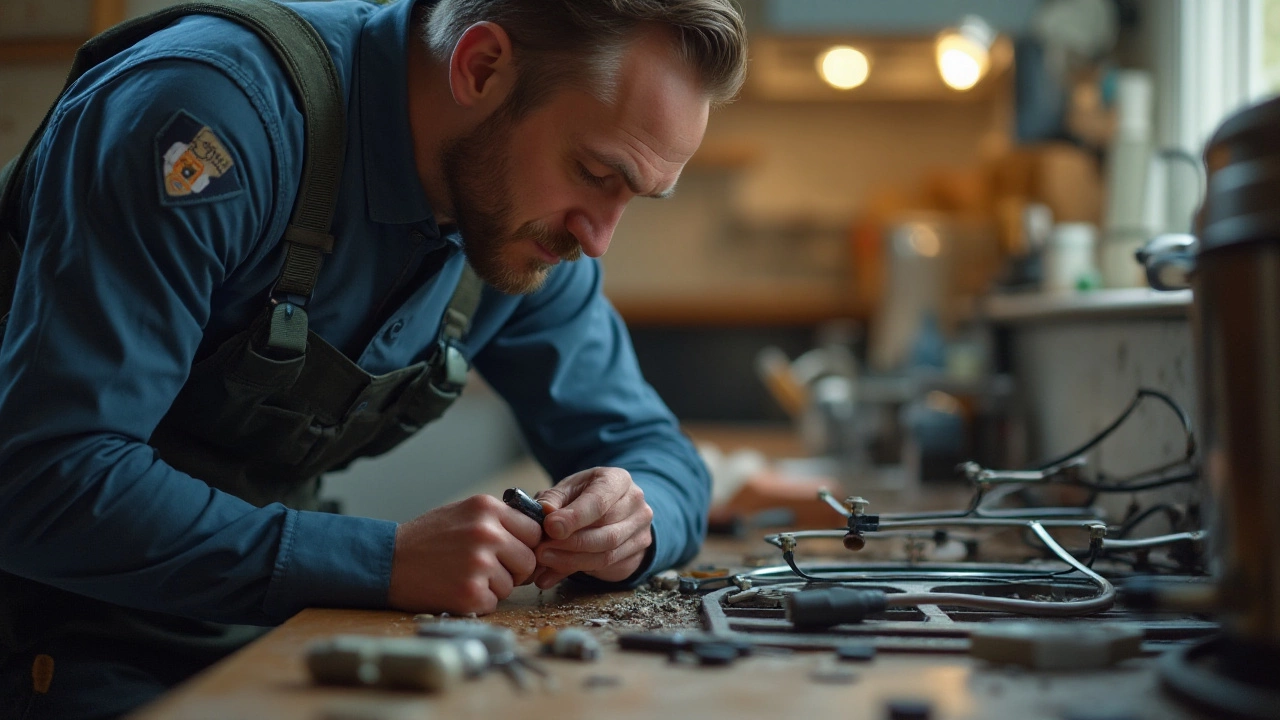There's nothing quite as frustrating as standing in the kitchen, ready to whip up a feast, only to find that your trusty cooker has decided to go on an unplanned strike. Before resigning yourself to microwave meals, let's delve into some of the common culprits behind this culinary conundrum.
As with any problem, understanding the root cause is half the battle won. From power supply hiccups to those pesky gremlins in the wiring, a cooker can stop working for a multitude of reasons. Knowing what to look for can save time and reduce the stress of being unable to cook your favorite dish.
- Initial Checks and Safety First
- Common Electrical Issues
- Dealing with Faulty Components
- User Errors and Simple Fixes
Initial Checks and Safety First
Losing the use of your cooker is inconvenient, but before jumping to conclusions about needing professional help, there are a few important initial checks you should perform. First, let's talk about safety. Ensuring your safety and that of your household is paramount. Start by making sure that your cooker is switched off at the power supply. Electricity and kitchen accidents are not a mix you want to entertain. According to the Energy Safety Service, working with any faulty electrical appliances requires diligence and precaution to prevent any mishaps.
Once you’ve ensured the power is off, take a moment to consider if there have been any power cuts or fuses that might have blown. An electricity interruption happens more often than one might think. It is worth checking whether other electrical appliances in your kitchen are functioning, giving you a clue if it might be a broader power issue. If your cooker is primarily gas-powered, ensure there's no disruption in the gas supply. Sometimes, the problem isn’t with the cooker itself, but with fuel supplying problems.
Another simple check lies in examining the socket where your cooker is plugged in. Faulty sockets can cause a myriad of problems, so it's beneficial to test another appliance with the same socket, which can indicate whether the issue is with the cooker or the plug itself. If the socket seems problematic, it might be time to call in an electrician to get it fixed. Remember, handling electrical wiring without proper expertise can be dangerous.
Moving on, inspect the cooker’s manual and look for any troubleshooting advice provided by the manufacturer. Often, manufacturers include quick fixes specific to their appliances, addressing common problems that could easily be overlooked by users. Many cookers have lights or audible alarms designed to indicate specific issues, so paying attention to these signals can be invaluable in diagnosing the problem early on.
"A proactive approach in identifying and understanding minor malfunctions can lead to significant savings in time and repairs," noted by the New Zealand Consumer advocacy group.
While reviewing the manual, keep an eye out for any information about resetting the cooker. Modern cookers sometimes include reset buttons, meant to help reboot the system and potentially clear minor glitches. Resetting might just do the trick and get your cooker working again, which makes life a tad easier, doesn’t it?
Finally, remember that the best preventative measure against cooker issues is regular maintenance. Clean the cooker regularly to prevent residue buildup that may interfere with its functionality. A well-maintained appliance does much better in serving its purpose with fewer unexpected interruptions. As a rule of thumb, pay attention to unusual sounds or behaviors – acting early can prevent issues from escalating.

Common Electrical Issues
Dealing with an unresponsive cooker is often like solving a small mystery, and the electrical system plays a leading role in this drama. When a cooker not working, electrical issues are frequently the villain behind the scenes. Whether your cooker operates with gas ignition or is fully electric, an interruption in power can halt operations immediately. The first thing to check is the power cord and plug; a slightly loose plug can cut off the electricity needed to heat those burners or elements. Inspect the plug and outlet for any signs of burning or damage, as these can indicate wiring problems that require professional attention.
On some occasions, the fault is with the circuit breaker. Cookers draw significant amounts of power, which can trip a breaker if there is even a slight hint of overload or a momentary surge. Take a moment to look at your breaker box; if the lever has shifted, a simple reset might solve your problem. However, if your breaker frequently trips, it could signal deeper issues in your home's electrical system that should not be ignored. Seek advice from a qualified electrician to ensure the safety and efficiency of your power setup.
"Safety should be a priority when dealing with electrical problems in home appliances," advises James Reid, an experienced electrician. "Never ignore a repeatedly tripped circuit breaker, as it could prevent potential hazards."
Some modern cookers include a fuse in the circuit design, which acts as a safeguard against unexpected electrical surges. These fuses are generally located inside the body of the cooker and may require some disassembly to access. Ensure the appliance is unplugged before attempting to replace any internal fuses. Always replace a blown fuse with one of the identical rating and type to avoid voiding any warranties or causing additional electrical complications.
Wiring and Internal Components
Delving further into the internal workings reveals more potential electrical snafus. The internal wiring of your cooker could suffer damage from regular wear and tear, pests, or even improper cleaning methods. Wires can become loose or frayed, which interrupts the steady flow of electricity to crucial components. Such issues might present themselves through inconsistent heating, loud humming noises, or the dreaded complete shutdown. Engaging with a professional appliance repair technicien for thorough examination is highly recommended to preserve both the functionality and safety of your cooker.
Lastly, cooking elements and burners require specific electrical contact to function. Sometimes, they simply need cleaning or adjusting for better contact with the electrical sources. Corrosion can form between connectors, creating barriers that electricity struggles to cross. Cooker repair might merely involve adjusting or cleaning these elements, which, although simple, can restore your appliance's full prowess.

Dealing with Faulty Components
Diving into the heart of your cooker can often illuminate the mystery behind its refusal to function. Cookers, like most things, can sometimes have a mind of their own, especially when a component decides it's time to retire. Identifying which component is at fault requires a bit of detective work, but it's not as daunting as it might seem. Think of it as a puzzle, where you can start with the most common components known to fail. For instance, the burners are notorious culprits when it comes to malfunctioning. If you’ve noticed that one or more burners are not heating properly or at all, it may be due to a broken burner coil or an issue with the burner socket.
Moreover, the power outlet all cookers rely on can be another source of trouble. Sometimes, the problem isn’t within the cooker itself but the electrical connection. Ensure your cooker is plugged into a functional outlet and examine the power cord for any frays or tears. These small checks can prevent bigger headaches and help swiftly pinpoint where the issue may lie. Another component worth investigating is the thermostat. It's pivotal for maintaining correct temperatures. A faulty thermostat may result in your cooker overheating or failing to heat at all, which can certainly test one’s patience. Testing it with the help of a multimeter can provide insights into whether it's functioning as it should.
"Many common problems with kitchen appliances can be traced back to worn-out parts that need replacement, not an entire replacement of the unit," says home repair expert Emily Lyons.
Next on the checklist is the oven door. While it may seem trivial, an oven door that doesn’t seal properly is more influential than you’d think. Imagine baking a cake while always leaving the oven door slightly ajar. Heat escapes, causing uneven cooking or longer cooking times. Ensure the door seal is in good condition and replace it if it's not. If these components check out without issues, it might be time to delve deeper into the more intricate parts of the cooker. Circuit boards and switches might need a thorough examination, and these are best handled by professionals. After all, safety first!
If you're a tad intimidated by the inner workings of a cooker, consider consulting the user's manual. It often provides a treasure trove of information regarding troubleshooting specific to your cooker model. Much like people, not all cookers are the same, and understanding their unique quirks can make all the difference. In situations where the component failure isn’t apparent, consulting with a professional can save both time and peace of mind. Remember, the journey to a well-functioning cooker could lie in something as simple as replacing a faulty part, breathing new life into your kitchen's star player.

User Errors and Simple Fixes
When dealing with a cooker repair scenario, one of the most overlooked aspects is the possibility of user errors. Sometimes, in our rush to get things done, we make small mistakes that can lead to a cooker not working as expected. One of the most common is failing to set the timer correctly or inadvertently switching the cooker to a different mode. It's worth mentioning that modern cookers come with numerous settings and features that can be unfamiliarly tricky, especially if you skip the manual. Make sure to double-check the dials and switches, ensuring everything is set as intended for cooking.
Another typical issue lies with cleaning routines. While keeping your cooker sparkling clean is generally a good idea, be cautious. In some instances, overzealous cleaning can lead to moisture getting into controls or igniters, particularly in gas cookers, causing them to malfunction. Pro tip: always leave time for parts to dry thoroughly before using the cooker again. On the topic of cleaning, ensure that filters, if your cooker has them, are not clogged. A blocked filter can sometimes mimic the symptoms of a malfunctioning cooker.
Despite our best efforts, sometimes we forget the basics. Is the cooker plugged in properly? Is the circuit breaker tripped? Although these questions might sound too simplistic, they’re vital starting points for troubleshooting when your cooker refuses to do its job. According to a well-known kitchen technology expert, "Unseen interruptions in power supply are some of the most frequent causes I come across in cooker complaints."
Forgetting such simple checks can lead to unnecessary stress and service calls."
Occasionally, error codes display on the electronic display of more advanced cookers. These are not just random numbers. They are crucial indicators that help diagnose the problem. Make sure to refer to your cooker’s manual or the manufacturer’s website for explanations of these error codes. Often, they reveal simple issues that can be resolved without professional help. Others might require a reset procedure, typically outlined step-by-step in most manuals. Resetting might surprisingly bring your appliance back from the brink.
For those experiencing issues with specific settings such as the grill not working while the oven functions perfectly, it could be as simple as ensuring you have activated the grill function correctly. Sometimes the selector switch may not be fully engaged, preventing the component from operating. If buttons are sticking or knobs are loose, ensure that these control mechanisms are clean and in good condition. If not, they can be the source of the issue. Even the simple misalignment of a knob can disrupt the operational flow of a cooker.
Consider making a checklist of these troubleshooting cooker steps to ensure that your next encounter with a non-working cooker won't cause unnecessary anguish. It’s both empowering and cost-effective to resolve these issues independently before calling in the pros. However, if these tips don't bring the desired results, reaching out to professional services is always a wise decision.


